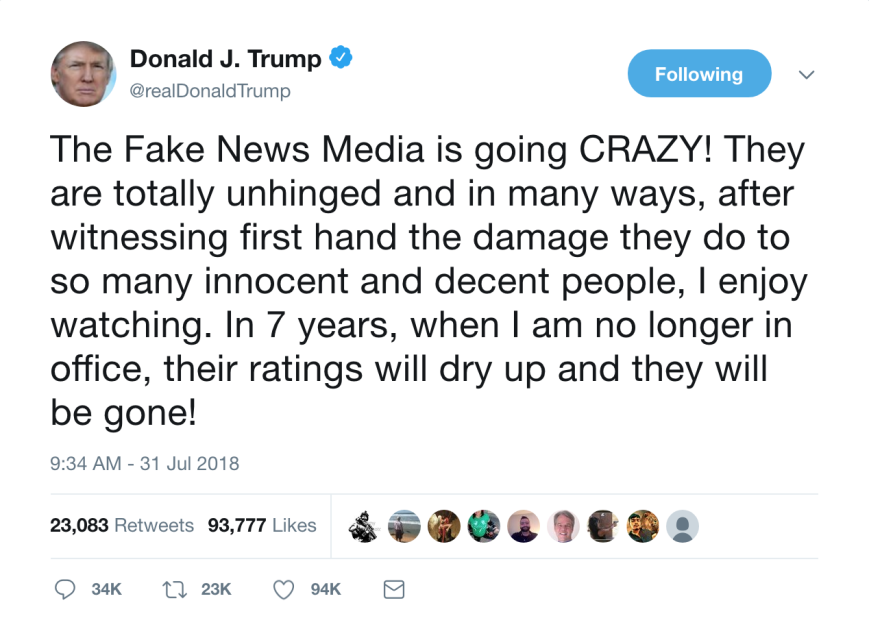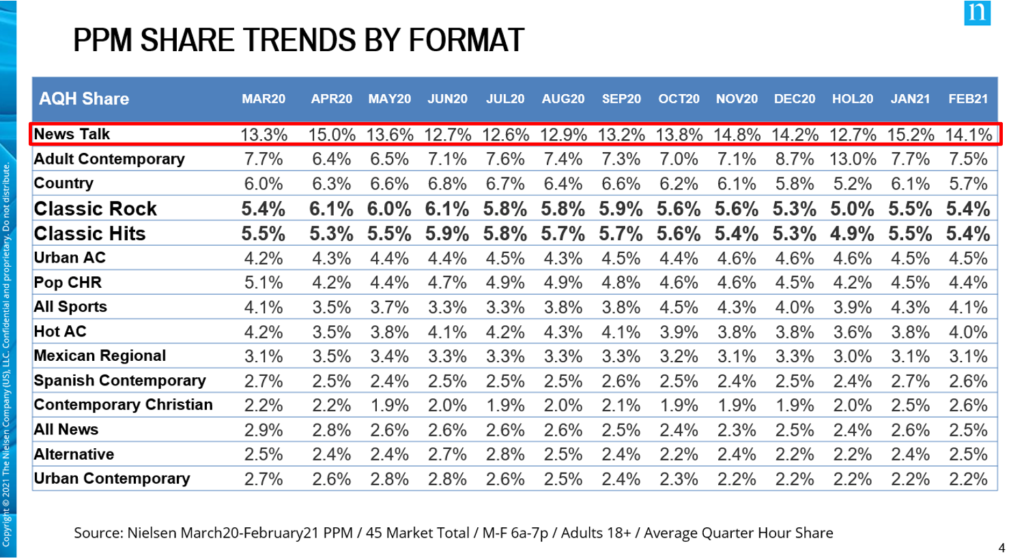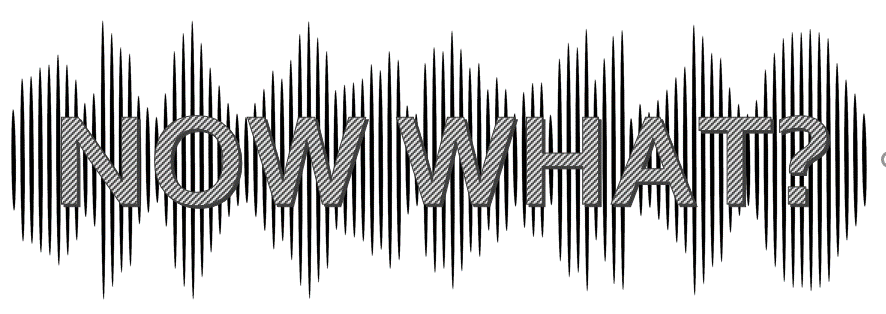
One thing we learned in 2020 – life is certainly not predictable. None of us could possibly have imagined back in January of that year that our lives would be turned upside-down in just a few short weeks.
The events of the last 12 months have been stark reminders that nothing is for certain until it happens. And even then, there are good reasons to hold your powder. Whether it’s your personal life (planning for weddings and celebrations, travel, going away to school) or your career, the last year has been an unprecedented period for dashed plans, and for so many things to not work out as predicted.
But I believe there is one thing that will come true this year. In fact, you could make the case that it’s already happening. And none other than former-President Trump predicted it:
His departure from the White House would change the news cycle.
You can already feel it happening, perhaps turbocharged by his Twitter ban, and other social networks. While the ex-Tweeter In Chief is promising to invent his own social media platform (announcement coming in the next 3-4 months, according to spokesperson Jason Miller), it is difficult to fathom how he will manage to stir the daily drink from Mar-a-Lago. In just the past several weeks, his profile has already receded, overshadowed by current and louder news stories – the vaccine rollout, the Southern border, mass shootings, the NCAA Tournament – that demand our attention.
How powerful was the so-called Trump Bump? Jacobs Media conducted research for various public radio stations, starting with the 2016 primaries, and continuing through Trump’s term.
and continuing through Trump’s term.
Whether you were on the Fox News or CNN side of the spectrum, chances are you were consuming more news. In 2020, the noise level may have reached a zenith, thanks in no small part to COVID, the election, and the controversy that followed in November, December, and even into 2021.
The new Nielsen PPM numbers for February are hot off the presses, and the News/Talk format is the undisputed winner. While that’s pretty much always the case, you can see 2020 was a predictably great year for the format. And the first two months of the new year have been stellar:

But like all Nielsen reports, this chart is ancient history, not reflective of current events. It covers a world that was weeks ago. While it’s important to try to understand what happened, these results should not confuse our grasp of what’s happening right now
To make the analytical process more ambiguous, the News/Talk category combines commercial radio’s version of the formats (all news and talk) with NPR News stations.
A look at many PPM markets again this February shows that many stations in this category enjoyed solid ratings, especially those in the public radio column.
Especially in the largest metros, these stations uncharacteristically have found themselves hovering at or near the top of the heap. WTOP and WAMU in Washington, KQED and KCBS-AM in San Francisco, WBZ-AM in Boston, KIRO and KUOW in Seattle – the list is a long one.
Headlines like the one below from Chicago’s Rob Feder tell you all you need to know about how things have been trending – long after the votes were counted – and recounted – and recounted since Election Day in early November.

But now there are signs on the horizon the “Trump Bump” as it’s been called may be giving way to a “Trump Slump.” News runs in cycles, and this one has lasted the better part of five years.
A story in The Washington Post focuses on declining cable news ratings by Paul Farhi, “Trump predicted news ratings would ‘tank if I’m not there.’ He wasn’t wrong,” finds the declines are evident.
The Post notes that even its own web traffic cratered in February, in step with most other news websites. But the hit for CNN has been worst of its cable news competitors, down 45% in prime over the last month or so, according to Nielsen. MSNBC is sharply down, while Fox News has just been nicked (-6%) since Joe Biden took office.
 Anecdotally, I’m feeling it. That urgency to hear or see the latest news has ebbed these past several weeks, replaced by a greater sense of calm – not to mention a lot more music and more and more sports. Reading the TV tea leaves suggests that news numbers are, in fact, headed south as the recovery – from COVID and the economic hit – is underway. Improving weather in much of the country might even accelerate this process.
Anecdotally, I’m feeling it. That urgency to hear or see the latest news has ebbed these past several weeks, replaced by a greater sense of calm – not to mention a lot more music and more and more sports. Reading the TV tea leaves suggests that news numbers are, in fact, headed south as the recovery – from COVID and the economic hit – is underway. Improving weather in much of the country might even accelerate this process.
If you’re on the News/Talk side of the spectrum, all is not lost. Many stations attracted new fans during the “Bump,” not all of whom will go away. And the most strategic of the organizations cleverly used Trump’s chaotic leadership style as a way to spin-off their resources. I refer to it as “asset allocation” – how brands can best utilize their talent and equity to extend into other verticals and distribution outlets.
The New York Times has enjoyed much success during this time, especially on the digital side of the spectrum where eyeballs and dollar bills have skyrocketed in tandem. Remember, they created The Daily, their hot podcast, in January 2017 – coinciding closely with the launch of the Trump administration.
MSNBC has redeployed its talent in several different configurations. They took Chuck Todd, host of Meet the Press and stripped it into an everyday show. Pre-COVID, Chris Hayes started doing live shows with a studio audience on Friday nights, Rachel Maddow has been touring to hawk her books, and many of their team members and contributors have launched podcasts. These are the assets that could continue generating revenue and fandom, even in a calmer environment.

Many radio brands in the News/Talk world have similar talent assets that can be utilized to fill the gap when enthusiasm with news and issue-oriented politics wane. But so do many music stations. Where there’s strong hometown talent, there are opportunities to extend personality brands into these other media verticals.
Public radio – especially on the network level – has also excelled with podcasts, but creating experiences for its fans is an area where perhaps it’s fallen short. As the pandemic wanes, event marketing will return in different forms, providing media brands with additional touch points – and potentially, profit centers.
But not without making commitments to developing more content. Farhi quotes Andrew Tyndall who writes an eponymously named newsletter that tracks network news ratings that we’ve entered “make-up-your-mind time” for news organizations.
You might make that same proclamation for radio – large and small markets, spoken word and music formats.
 Now that the attention is veering away from Washington, D.C., for a change, will there be a “Trump Dump” in the ratings for stations in the News/Talk category – or have they bolstered and protected their brands with strong content?
Now that the attention is veering away from Washington, D.C., for a change, will there be a “Trump Dump” in the ratings for stations in the News/Talk category – or have they bolstered and protected their brands with strong content?
And on the opposite side, how can radio brands of all stripes use a different mindset to enter a phase that is focused on leisure, travel, entertainment – and families?
Trump warned us. Even he may end up spending more time with his family.
- Media And Technology In 2025: Believe It Or Not! - April 18, 2025
- In Radio, You Just Never Know - April 17, 2025
- The Secret To Making A Great Podcast (And Great Radio) - April 16, 2025




Frank Sinatra “Cycles” into “Here Comes the Sun.”
Every dog has his day, Clark.
Hi Fred. I’m surprised your column didn’t mention to loss of Rush Limbaugh for AM Talkers’ immediate future. No matter who replaces him (who is so far? I’m ah… not a regular listener), I would guess it will be hard for stations to maintain his numbers. What do you think?
Definitely. And I should have said something. I was on a panel recently and the topic of Rush’s passing came up. My fellow panelists agreed he can’t be replaced. But it will be hard to recoup those numbers.
Talk radio had some major changes with the loss of Rush Limbaugh and Dr Michael Savage moving to podcast only.
Also Fox only being down 6% is a pretty big win for FOX, now that they have competition from OAN and Newsmax.
I agree with your assessment of Fox. But now they can go on the attack – a strategy that worked well the last 4 years on CNN and MSNBC.
I’d really keep an eye on some of the few major Hot Talk FMs that are still around–most notably, Tampa’s Bone (WHPT) and Orlando’s Real Radio (WTKS). They’ve been pretty strong for some time now.
Yup, not your standard conservative talk. Interesting how few of these stations exist. Is it that it’s easier to just plug-and-play with syndication. And/or the Hot Talk format works better with local hosts. Or something else?
Fred, IMO it’s a combination of several factors:
1. It takes time. Most stations don’t feel like they have time. Even great talents take a long time to develop, and great chemistry isn’t instantly formed. You literally are working out your act and dynamic on someone else’s airtime, as talent. So there’s not many “labs” to create this type of talk.
A lot of these shows started pre pandemic, and pre recession, and even under smaller groups or owners, which gave them the time and a bit less risk – which helped them find their groove. Few stations are going to jump into that pool right now, much as I wish they would.
2. It takes depth of personality – there’s great political talkers, that’s their act. But you take them out of rant mode and they can’t necessarily pivot well. In the same way many music jocks THINK they can do talk and can’t, many talkers can’t switch modes and themes easily. Anger in some ways is easier than comedy, nuance, or even just having a well of experiences to draw from that are relevant to non news nerds of whatever partisan stripe.
3. To go back to development, while great radio can make good podcasts, it’s harder to go in reverse (IMO) because podcasting can be a monologue. It doesn’t have the tactile feedback of the team or the “format” of radio, which while constraining to some is also a great disciplinary exercise in pacing and presentation.
4. It takes money. Live humans interacting, often as a team. It can pay off but we all know how that goes in the business reality of radio 2021.
I grew up on great talk radio, that didn’t have to be angry all the time to be compelling. I’d like to see it return, or be a part of it even, and I see a few talk stations still trying. Good for them, but sad they’re the exceptions.
Excellent thoughts here, Matt (and I agree with the reverse podcast premise). The lofty issues of time, money, and patience are big boulders in the road for most traditional radio companies. But all that said, it starts and ends with prescient strategic thinking. Your views on the state of radio talk in 2021 say it all. Thanks again for furthering the conversation.
How can we be surprised to observe that the fire brigade (news-talk) has fewer calls when the area’s most infamous arsonist (you know who) has left town?
That’s pretty much the way I see it, yes.